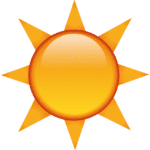Why Do I Have Moss in My Lawn?
Moss is one of the most persistent and annoying weeds that occur in home lawns. It grows in thin, weak turfgrasses, but does not thrive in strands of dense, vigorous turf.
Why is Moss Growing in my Lawn?
There are several reasons why a lawn is mostly moss. Moss in a lawn is a sign that the environment is not ideal for grass to grow.
Moss is an opportunistic plant that will develop and grow in bare soil areas or where turfgrasses are weak and thin. Moss does not “crowd out” turfgrasses, but once it is established, grass plants will not spread into those areas.
How to get Rid of Moss in My Lawn?
The process to eliminate moss in a lawn requires changing the conditions to be more ‘grass-friendly’.
To control moss, you must carefully consider the reasons why it began to grow in your lawn. Moss usually thrives as a result of conditions that are not conducive to good turf growth, such as shallow, rocky soils; poor soil fertility; low soil pH (acid soils); heavy shade; and excessive moisture. If any of these factors limit turf growth, moss can invade the lawn and establish residence.
The first step in a moss control program is to test the soil for nutrient content and pH.
The test will determine if the soil is lacking nutrients that grass needs to thrive. It will also tell you the acidity of the soil and if the soil needs lime.
Most plants have a preference of soil – acidic, basic (a.k.a. alkaline) or neutral. When grass is growing in soil that is too acidic, it cannot use the nutrients that are available.
You could apply the best blend of fertilizers, at the perfect times of the year, in the ideal amounts, and if the soil is too acidic, it would not be able to use those nutrients.
The soil test report will tell you how much fertilizer and lime to apply – and when to apply them.
Over time, improved soil conditions resulting from fertilizer and lime applications will help your grass compete with the moss.
Moss Likes Shade, Grass Likes Sun 
Even shade-tolerant grass types need at least 4-5 hours of direct sunlight a day. Moss, on the other hand likes shade (that’s why moss mostly grows on the north side of trees). So, a lawn with a lot of shade is not good for grass but it is good for moss.
If shade and/or moisture are the limiting factors for good turf growth, take steps to correct the situation.
For example, remove some trees or tree branches to increase sunlight and air circulation. Planting grasses that are adapted to shaded or moist areas.
What Grass is Best for Shady Areas?
Fine fescues adapt best to shaded, well-drained soils, while rough bluegrass is better adapted to shaded, moist soils. Neither of these species will survive in extremely heavy shade or soils that are saturated for long periods of time.
Only after the limiting factors for good turf growth have been corrected should you attempt to eliminate moss with chemicals.

Lawn Care
Green Giant Home & Commercial’s Lawn Care services control weeds, build the thickness and density of your lawn and protect it from being damaged by insects and disease, providing you with a great-looking, healthy lawn. We offer fertilization, weed control, liming, insect control, and aeration and overseeding. Visit our Lawn Care page for more information.
Tree Care
Green Giant performs: Proper Diagnosis and Treatment of Tree & Shrub Problems, Insect & Disease Control (including Spotted Lanternfly), and Nutrient Management via Deep Root Fertilization to keep your plants healthy and thriving. Visit our Tree Care page for more information.
Vegetation Management
Green Giant’s Non-Lawn Weed Control services eliminate unwanted vegetation in a wide variety of locations for both residential and large commercial/municipal properties. Areas include fence lines, around obstacles to reduce weed eating, stone/gravel driveways & parking lots, swales, roadside/curbside vegetation management and more. Find more information, visit our Vegetation Management page.
Pest Control
Our full service pest control division provides both Year-Round Service Programs that cover the vast majority of pests that you will encounter and also One-Time Corrective Services for pests such as bees, ants, termites or mice. For more information, visit our Pest Control page.